- Home
- Nicholson Baker
Mezzanine Page 9
Mezzanine Read online
Page 9
But a year of riding the escalator to work changed me. Now I was a passenger on the machine four times a day—sometimes six or more, if I had to redescend to the lobby to take the elevator to one of the company’s departments on the twenty-sixth or -seventh floor—and the habitual thoughts that the experience had previously called forth became too familiar at that frequency. My total appreciation for the escalator deepened, eventually becoming embedded along my spinal column, but each individual ride was no longer guaranteed to trigger a well-worn piece of theory or state of irritation. I began to care less whether the original intent of the invention had been to emulate the stairway or not. And when I went back to department stores after those early months of work, I regarded the big motionless backs of shoppers ahead of me on the crowded slope with new interest, and I relaxed with them: it was natural, it was understandable, it was defensible to want to stand like an Easter Island monument in this trance of motorized ascension through architectures of retailing. Fairly early on, riding up to Housewares to buy a Revere saucepan to pair with my Teflon fry pan and complete my kitchen,1 I even put my shopping bag (which contained a suit, a shirt, a tie, and, in a separate smaller bag from Radio Shack, a longer telephone cord) down on the step beside me and closed my eyes for a short while. I brought this new pleasure of standing still back with me to the workday escalations; and eventually I underwent a complete reversal: I never brought my long, leisurely trip to an early end with steps of my own, enjoying it as seasoned rail commuters enjoy the fixed interval of their train ride—and when people stumped past me I regarded them with sympathy. In special situations, the old irritation did occasionally come back, especially on subway escalators; but when it did I now divided my blame between the halted pedestrians and the original designers of the machine: clearly the engineers had made the risers of the steps too tall, and the height weakened the functional correspondence between these stairs and their home counterparts, so that riders failed to feel innately that they were expected to climb.
I was now close to two-thirds of the way to the mezzanine. Behind me, at the base, the maintenance man had moved his rag to the handrail I was holding—in another revolution, my handprint would be polished away. Every few feet, my hand moved past a raised disk of burnished steel attached to the slope between the up escalator I rode and the down escalator to my left. I followed the disks with my eyes as they went by. I had never figured out what their purpose was. Did they cover the heads of large structural bolts, or were they there simply to discourage anyone who might be tempted to use the long median slope as a slide? This question, compressed into a blip of familiar curiosity, occurred to me once or twice a quarter, never urgently enough for me to remember it later and find out the answer.
Presently the metal disk that drew near was half lit by sun. Falling from dusty heights of thermal glass over a hundredvaned, thirty-foot-long, unlooked-at, invisibly suspended lighting fixture that resembled the metal grid in an old-style ice cube tray, falling through the vacant middle reaches of lobby space, the sunlight draped itself over my escalator and continued from there, diminished by three-quarters, down into a newsstand inset into the marble at the rear of the lobby. I felt myself rise into its shape: my hand turned gold, coronas of stage-struck protein iridesced from my eyelashes; and one hinge of my glasses began to sparkle for attention. The transformation wasn’t instantaneous; it seemed to take about as long as the wires in a toaster take to turn orange. It was the last good blast of lunch hour; possibly the best part of the escalator ride. My moving shadow appeared far off, sliding on the lobby floor, and then it began folding itself over the sunlit piles of magazines in the newsstand—magazines as thick as textbooks, separated by wooden dividers—Forbes, Vogue, Playboy, Glamour, PC World, M—so filled with ads that they made a splashing sound as you flipped through their cool, Kromekote pages. Incited by bright textures and warmth, four distinct images occurred to me in quick succession, three of them familiar, one of them new to me, each suggesting the next. I pictured:
(1) The lines of Creamsicle-colored shine on the shrink-wrapped edges of the row of record albums in my living room as they appeared in the evening when I came home from work.
(2) A discarded cigarette pack still wrapped in its cellophane; specifically, the delight of running a lawn mower over it, buzzing its glints and paper out over the dry grass.
(3) The mowed remains of a dinner roll I had seen once on a nice Saturday morning on the way to the subway. It was a potato-sized dinner roll, judging by the white shards, and bending closer, I recognized it as the kind of tasteless lovable roll that was included free with your order from a nearby Chinese takeout place. It had been mowed over where it lay that morning on the sharp slope that fell to the sidewalk (the street must have been widened at some point in the past): looking at it, I had imagined the flicker of indecision on the mower’s sweaty face—”Rock?—No, a roll.—Stop?—Not on this tricky slope—Push on,” and then the dip of the engine’s drone and the card-shuffling spatter that followed, leaving, in place of a Chinese dinner roll, a neat circular distribution of white fragments.
(4) A giant piece of popcorn exploding in deep space. This last was a conception I had never envisioned in isolation before. Its brief appearance on the heels of the mowed roll (an image that occurred to me once every few months) was probably explained by my having bought and eaten a bag of popcorn earlier in the lunch hour.
Chapter Thirteen
I HAD NOT INTENDED to buy a bag of popcorn. Under the impetus of a big-necked man and a rushed woman behind him, the revolving door from the lobby had been circulating a little too fast; when my turn came, I took advantage of the existing momentum by milling through my slice of its pie chart without contributing any additional force, rolling up a sleeve. Outside, it was noontime, noontime! Fifteen healthy, coltish, slender trees grew out of the brick plaza a short way into the blue sky in front of my building, each casting an arrangement of potato chip—shaped shadows over its circular cast-iron trunk collar. (“Neenah Foundry Co. Neenah, Wis.”) Men and women, seated on benches in the sun near raised beds of familiar corporate evergreens (cotoneaster, I think) were withdrawing wrapped delicacies from dazzling white bags. Sidewalk vendors poked in the ranked compartments of their carts, flipping metal doors back and forth. The rear of a truck with quilted metal sides was packed with sandwiches, spigots, Drake’s Cakes, and cans in ice, its owner making change from the monetary calliope on his belt, filling three cups at a time without flipping on and off the coffee spigot, pointing at the next customer, all in looping, circling two-armed gestures, as I imagine master telephone operators working the old plug and -socket switchboards must have made—he was selling to the crew that was tearing down everything but the I beams and the front façade of a building across the street. I was hungry, but under this sunlit noon mood I needed something insubstantial and altitudinous, like a miniature can of Bluebird grapefruit juice, or half an arrowroot biscuit, or three capers rolling around a paper plate, or: popcorn. On impulse, I let a complete dollar fall into the popcorn vendress’s hand and lifted a twist-tied bagful garnered from the cart’s glass poppery, with its 1890s-style painted lettering and yellow heat lamps and suspended popping chamber, out of which individual white fulsomenesses were jumping from under a metal hinged flap, as if doing a circus stunt for the blank drifts that composed the audience—and I got no change back; no change at all to abrade my thigh as I walked or to overflow my bureau saucer that evening! How kind of her! As I jaywalked across several streets in the direction of the CVS, trailing the inevitable two or three particles from each handful that exceeded the mouth’s capacity, moving between cars whose lacquer looked hot to the touch and pedestrians in white blouses and white pinpoint oxford shirts, I felt somewhat like an exploding popcorn myself: a dried bicuspid of American grain dropped into a lucid gold liquid pressed from less fortunate brother kernels, subjected to heat, and suddenly allowed to flourish outward in an instantaneous detonation of weightless reversa
l; an asteroid of Styrofoam, much larger but seemingly of less mass than before, composed of exfoliations that in bursting beyond their outer carapace were nonetheless guided into paisleys and baobabs and related white Fibonaccia by its disappearing, back-arching browned petals (which later found their way into the space between molars and gums), shapes which seemed quite Brazilian and intemperate for so North American a seed, and which seemed, despite the abrupt assumption of their final state, the convulsive, launching “pop,” slowly arrived at, like risen dough or cave mushrooms.1
It took me ten minutes to walk to the CVS pharmacy. I threw out what was left of the popcorn before I went inside, into a square can out front with a flap sticky from soft drinks: the trick here was to use whatever you were throwing out to push the flap open and then snap your hand out of the way quickly enough that the flap didn’t fall back on it, a technique that didn’t work perfectly in this case because the receptacle was overfull and I had to crush my popcorn bag down into earlier trash so that the flap could swing shut properly. I wiped popcorn salt and oil from my hands onto the inside of my pants pockets and entered the coolness of the store.
I had no idea where the shoelaces were kept, but I was a frequent customer of CVSes all over the city, and considered myself an old hand at their layouts and their odd systems of classification. “eye care,” “headache,” “hair notions,” read the suspended placards, with a once catchy, now dated absence of initial capitals—but few, I thought, knew as I did to find earplugs in a far aisle called “first aid,” near swimmer’s nose-clips, Ace knee supporters, Cruex, Caladryl, Li-Ban lice-killing spray, and the Band-Aid shelves. In fact, most of my familiarity with CVS stores had come from my regular purchase of earplugs. I used a box or more of them a week, and over the years I had grown fond of their recherché placement, implying, which was often true, that hearing was an affliction, a symptom to be cured. The aisle, moreover, was never crowded with pill-studiers, as “headache” was, and all of those nearby boxes of Band-Aids, still trustingly unsealed, with specialized shapes for unusual wounds and the bonus row of miniature strips that adults used even for quite bad finger-cuts, such as you get slicing through a presliced bagel, because they were less ostentatious and self-pitying than the standard size, seemed to me to be the heart of the whole pharmacy. Incidentally, if you open a Band-Aid box, it will exhale a smell (as I found out recently, needing a Band-Aid for a surprisingly gruesome little cut1) that will shoot you directly back to when you were four2—although I don’t trust this olfactory memory trick anymore, because it seems to be a hardware bug in the neural workings of the sense of smell, a low-level sort of tie-in, underneath subtler strata of language and experience, between smell, vision, and self-love, which has been mistakenly exalted by some writers as something realer and purer and more sacredly significant than intellective memory, like the bubbles of swamp methane that awed provincials once took for UFOs.
I used a lot of earplugs, not only to get to sleep, but also at work, because I had found that the magnified Sensurround sounds of my own jaw and teeth, and the feeling of underwater fullness in my ears, and the muffling of all external noise, even the printing of my own calculator or the sliding of one piece of paper over another, helped me to concentrate. On some days, writing impassioned memos to senior management, I spent the whole morning and afternoon wearing earplugs—wearing them even to the men’s room, and taking only one out to talk on the phone. Lunch hours I never wore them; and possibly this explained why my thoughts had a different kind of upper harmonic during lunch: it wasn’t just the sunlight and the clean glasses, it was also that I heard the world distinctly for the first time since walking to the subway in the morning. (I wore them in the subway, too.) I used Flents Silaflex silicone earplugs. Only since 1982 or so have these superb plugs been generally available, at least in the stores I visit. Before that I used the old Flents stopples, in the orange box—they were made of cotton impregnated with wax, and they were huge: you had to cut them in half with a pair of scissors to get a shape that would stay put when you worked it in place, and they left your fingers greasy with pink paraffin. They revolted L., who used to store any I left on her bedside windowsill in an empty pastilles canister with a rural scene on it—and I don’t blame her. Then a company called McKeon Products began to be a force in the market, offering Mack’s Pillow Soft® earplugs—lumps of transparent gel-like putty that made a seal so complete that your eardrums ached slightly as you released the pressure from your fingers, because they were creating a mild vacuum in your ear canal—a vacuum! We all know how poorly sound travels in a vacuum! These new plugs, then, were not merely blocking soundwaves from passing through, they were altering the sonic characteristics of the very air resident in the canal! Their fame spread from drug chain to drug chain by word of mouth. I wore them until I forgot what true sound was. Flents counteracted powerfully, pushing their sleek Silaflex model—flesh-colored cylindrical versions of Mack’s—while gradually phasing out the old wax and-cotton Tootsie Roll behemoths. The Silaflex plugs, like Mack’s, were sold in a plastic snap-open carrying case, like a snuffbox; I carried the case around in my shirt pocket so that I could have new earplugs whenever I needed them. Fearing lawsuits, perhaps, Flents continued to oversize the newer product—though the package said “3 pairs in handy storage box,” I still twisted each cylinder in half and got six complete sets. In bed I kissed L. good night while she wrote down the events of her day in a spiral notebook, and then I selected a promising used plug from the array on my bedside table and pressed it into whichever ear was going to point toward the ceiling first. If she asked a question after I had put the plug in and turned on my side, I had to raise my head off the pillow, exposing the lower ear, to hear her. Earlier I had tried sleeping with earplugs in both ears, so that I would be sound-free as I revolved in my sleep, no matter which ear turned up, but what I found was that the pillow ear would be in pain by the early hours of the morning; so I learned how to transfer the single warm plug from ear to ear in my sleep whenever I turned. By this time L. was resigned to my wearing them; sometimes, to demonstrate special tenderness, she would get the wooden toaster tongs, take hold of an earplug with them, drop it in my ceilingward ear before I had gotten around to doing so, and tamp it in place, saying, “You see? You see how much I love you?”1
Just over from earplugs were the long-nosed white bottles of ear-wax dissolver, which I bought once a year or so. Whenever you discovered, on removing the night’s earplug after your alarm went off, that you did not hear any better with it out, you remained in bed and squirted the cold carbamide peroxide solution into your ear and lay motionless, waiting for a tactile ferment of bubbling to begin. Then you took a shower. It is true that this squirt of reagent wasn’t as effective as the mind-boggling steel warm-water blaster that nurses used: that device had two syringal finger-hooks and a thumb-actuated plunger, and it sent an almost unendurable surge of warm water into your head, flushing impurities out into a bedpan you held steady at your neck. After I had had my ears roared clean that way, I heard reaches of the hertzian range that I had not heard probably since I was newborn; and the greatest pleasure in hearing this new wheat-field crispness overlaid on normal sound was in being able to bottle it away when I wanted to with a pair of Silaflex earplugs. But I was embarrassed to ask a nurse to use the ear-blaster on me because she would see the impurities gush from my ear, so I often resorted to the do-it-yourself white bottle of CVS solvent, and afterward stood in the shower for the count of sixty with my head at an angle that allowed the hot water to enter my ear with as much flushing directness as possible. This was the kind of important and secretive product that CVS stores sold—they were a whole chain dedicated to making available the small, expensive, highly specialized items that readied human bodies for human civilization. Men and women eyed each other strangely here—unusual forces of attraction and furtiveness were at work. Things were for sale whose use demanded nudity and privacy. It was more a woman’s store than a man’s s
tore, but men were allowed to roam with complete freedom past shelves that glowed with low but measurable curie-levels of luridness. You slip by a woman reading the fine print on a disposable vinegar douche kit. She feels you pass. Frisson! Another woman is contemplating a box of Aspercreme—what for? A third is deciding whether she wants a Revlon eyelash curler, which looks like a cross between a tea strainer and a medieval catapult. Heavy curved soaps like Basis and Dove, though sold in perky square boxes, will be slid from their packaging for tonight’s shower: their cream-molded trademarks will be worn away by their passage over womanly upper arms and stomachs.1 When I was younger than I should have been, I used to steal sanitary napkins from the box among the shoes in my parents’ closet, where they lay folded like tennis sweaters in a drawer, and take them to the bathroom with me, where I would with some difficulty poke a hole in one of them, using a pencil or a toothbrush, push my crayon-sized penis through the hole, and urinate into the toilet—and CVS stores have some of this uncertain, childish kinkiness and indirection to them, mixing so many kinds of privateness together in one public store. Even if you are there just to buy some decongestant or, as I was, simply for a pair of shoelaces, you feel the subdued tantalization of the place: the Coppertone billboards used as wallpaper, square yards of tanned shoulders and knees and faces; Krazy Nails wallpaper, too; and Maalox and Secret antiperspirant and Energizer battery wallpaper, all of the ex-billboards cropped and overlapping, obscured here and there by circular antitheft mirrors. Deeply confidential names whispered up at you from every aisle—Anbesol, Pamprin, Evenflo, Tronolane—masterly syllabic splicings of the perverted and the doctorly, the pattern of each color package repeated in piles of four and eight and ten on the shelf. It was a whole Istanbul of the medicine cabinet, insulated from the street by the Red Cross innocence and purity of the CVS sign.

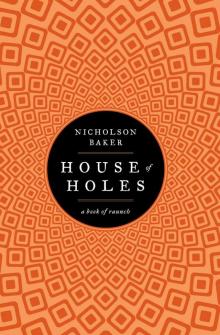 House of Holes
House of Holes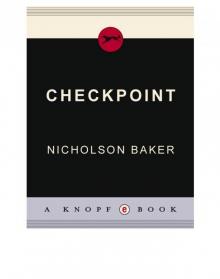 Checkpoint
Checkpoint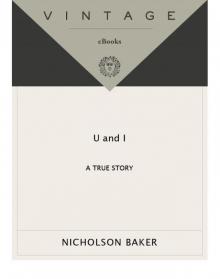 U and I
U and I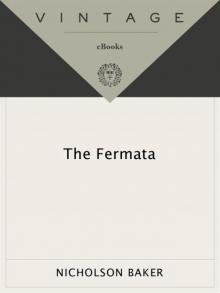 The Fermata
The Fermata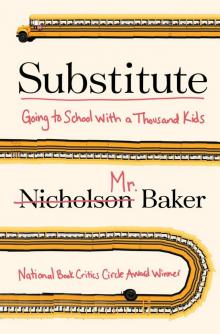 Substitute
Substitute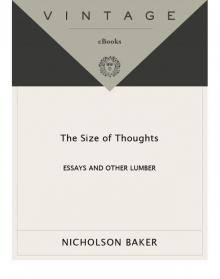 The Size of Thoughts
The Size of Thoughts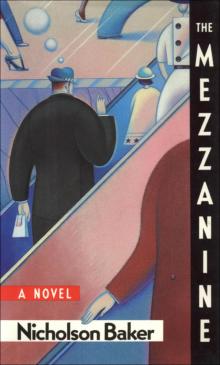 Mezzanine
Mezzanine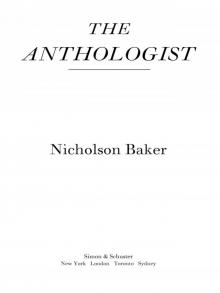 The Anthologist
The Anthologist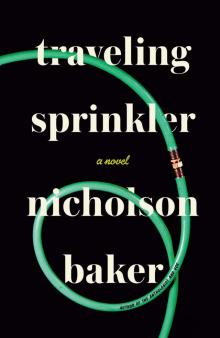 Traveling Sprinkler
Traveling Sprinkler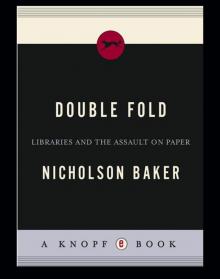 Double Fold
Double Fold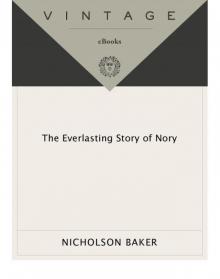 The Everlasting Story of Nory
The Everlasting Story of Nory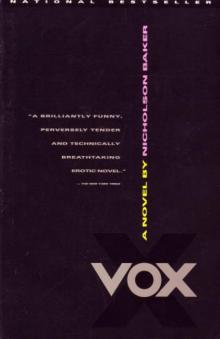 Vox
Vox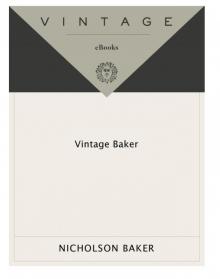 Vintage Baker
Vintage Baker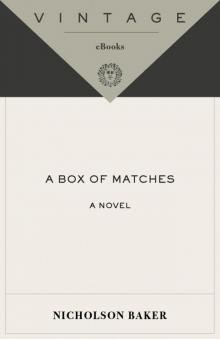 A Box of Matches
A Box of Matches